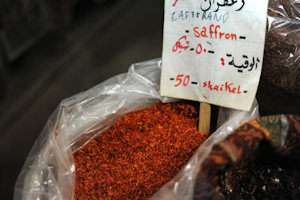Saffron – Expensive, but as Internationally Loved as The Olympics
- 08, 20, 2016
- Category Uncategorized
- Posted By TheraCuisine
- Comments Off on Saffron – Expensive, but as Internationally Loved as The Olympics
 Saffron is the most expensive spice in the world! This is due to its difficulty to produce in mass quantity. Saffron comes from the saffron crocus flower (crocus sativus) which originated from Western Asia and is now cultivated all over the world – but primarily in Spain, Iran, Greece and India. Saffron is a bulbous herb that produces a purple colored flower which blooms in the fall and which contains three orange-reddish colored female stigmas and three yellow colored male stamens in the center of the flower. The female stigmas have to be handpicked from the flower when it is fully opened and fresh and then be gently dried before they become the prized spice we call “Saffron”. It takes 225,000 crocus flower stigmas to produce one pound of saffron. Since this process cannot be mechanized it translates into a very expensive commodity.
Saffron is the most expensive spice in the world! This is due to its difficulty to produce in mass quantity. Saffron comes from the saffron crocus flower (crocus sativus) which originated from Western Asia and is now cultivated all over the world – but primarily in Spain, Iran, Greece and India. Saffron is a bulbous herb that produces a purple colored flower which blooms in the fall and which contains three orange-reddish colored female stigmas and three yellow colored male stamens in the center of the flower. The female stigmas have to be handpicked from the flower when it is fully opened and fresh and then be gently dried before they become the prized spice we call “Saffron”. It takes 225,000 crocus flower stigmas to produce one pound of saffron. Since this process cannot be mechanized it translates into a very expensive commodity.
Saffron is used as a spice in cooking to lend flavor and color. Luckily, a very small amount of Saffron goes a long way in recipes. The thread like pieces of saffron are either soaked in a little liquid first to draw out it’s striking golden yellow hue and then added to dry ingredients, or the whole threads are slightly crushed and then added directly to wet ingredients. Saffron has a distinct flavor that is best described as herbaceous and musty, slightly bitter and earthy. Dishes from cultures around the world feature this exotic spice. Some of the more famous dishes include Spain’s Paella, Italy’s Risotto Milanese, Morocco’s Chermoula Sauce, India’s Biryanis, Sweden’s Bakery Goods, England’s Cornish Buns, France’s Bouillabaisse and Iran’s National Dish – Chelow Kabab. You may want to try making one of these classic recipes or perhaps just add a pinch (about 5-8 strings) of saffron to the cooking water of your next (four to six serving size) pot of rice pilaf. Note the distinct aroma and rich color that these few strings will infuse throughout your whole pot of rice. Once you have introduced yourself to this spice you will be able to detect its distinct presence among a myriad of other culinary concoctions. And yes, it is pricy but, its ability to be used so sparingly yet still make such a big impression, wins the gold in my spice cabinet.
Visit our Sponsors
Latest Recipes
- January is National Soup Month – Host a Soup Crawl
- Fiery, Sweet & Sour Cucumber Salad
- Celebrate In and Out of Season
- The Scoop on Honey
- Saffron – Expensive, but as Internationally Loved as The Olympics


